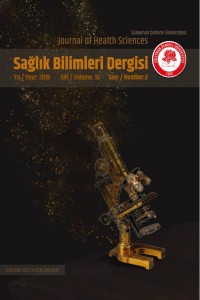Öz
Amaç:
Bu çalışma; Orta Karadeniz bölgesindeki çocuklarda yirmi yaş dişleri
haricindeki daimi dişlerde görülen konjenital diş eksikliklerin prevelansını
belirlemek amacıyla yapılmıştır.
Materyal Metod:
Bu çalışmada Ordu Üniversitesi Diş Hekimliği Fakültesi Ağız Diş ve Çene Cerrahisi
Anabilim dalına başvuran 6-12 yaşları arasındaki 996 çocuğun (460 kız, 536
erkek) panoramik radyografileri incelenmiştir. Konjenital diş kesikliğinin
cinsiyetler arası ve alt ve üst çene arası sıklığını analiz etmek için
Chi-square test uygulandı.
Bulgular:
Araştırmada konjenital daimi diş eksikliği prevalansı % 7,3 olarak bulundu (kızlarda % 6,5 ve
erkeklerde % 8) ve cinsiyete göre istatistiksel fark gözlenmedi. En sık
eksikliği gözlenen dişler sırası ile alt ikinci küçük azı, üst yan kesici ve
üst ikinci küçük azı olarak tespit edildi. Dört ayrı yarım çenede diş
eksiklikleri birbirine çok yakın değerler verdi ve karşı yarım çenelerdeki diş
eksikliklerinin simetrik olduğu görüldü.
Sonuç: Konjenital daimi diş eksikliklerinin erken dönemde tespitinin ileride
oluşabilecek diş ve çene uyumsuzluklarının önlenmesinin erken dönem tedbir ve
tedavilerle daha kolay olacağını düşünmekteyiz.
Anahtar Kelimeler
Kaynakça
- 1. Behr M, Proff P, Leitzmann M, Pretzel M, Handel G, Schmalz G, et al. Survey of congenitally missing teeth in orthodontic patients in Eastern Bavaria. European journal of orthodontics. 2011;33(1):32-6.
- 2. Bural C, Oztas E, Ozturk S, Bayraktar G. Multidisciplinary treatment of non-syndromic oligodontia. European journal of dentistry. 2012;6(2):218-26.
- 3. Parkin N, Elcock C, Smith RN, Griffin RC, Brook AH. The aetiology of hypodontia: the prevalence, severity and location of hypodontia within families. Archives of oral biology. 2009;54 Suppl 1:S52-6.
- 4. van Marrewijk DJ, van Stiphout MA, Reuland-Bosma W, Bronkhorst EM, Ongkosuwito EM. The relationship between craniofacial development and hypodontia in patients with Down syndrome. European journal of orthodontics. 2016;38(2):178-83.
- 5. Visinoni AF, Lisboa-Costa T, Pagnan NA, Chautard-Freire-Maia EA. Ectodermal dysplasias: clinical and molecular review. American journal of medical genetics Part A. 2009;149A(9):1980-2002.
- 6. Peker I, Kaya E, Darendeliler-Yaman S. Clinic and radiographical evaluation of non-syndromic hypodontia and hyperdontia in permanent dentition. Medicina oral, patologia oral y cirugia bucal. 2009;14(8):e393-7.
- 7. Punithavathy, John JB, Priya G, Elango I, Stalin. Famlial nonsyndromic oligodontia. Contemporary clinical dentistry. 2012;3(Suppl 2):S188-90.
- 8. Gracco ALT, Zanatta S, Forin Valvecchi F, Bignotti D, Perri A, Baciliero F. Prevalence of dental agenesis in a sample of Italian orthodontic patients: an epidemiological study. Progress in orthodontics. 2017;18(1):33.
- 9. Altug-Atac AT, Erdem D. Prevalence and distribution of dental anomalies in orthodontic patients. American journal of orthodontics and dentofacial orthopedics : official publication of the American Association of Orthodontists, its constituent societies, and the American Board of Orthodontics. 2007;131(4):510-4.
- 10. Goya HA, Tanaka S, Maeda T, Akimoto Y. An orthopantomographic study of hypodontia in permanent teeth of Japanese pediatric patients. Journal of oral science. 2008;50(2):143-50.
- 11. Tavajohi-Kermani H, Kapur R, Sciote JJ. Tooth agenesis and craniofacial morphology in an orthodontic population. American journal of orthodontics and dentofacial orthopedics : official publication of the American Association of Orthodontists, its constituent societies, and the American Board of Orthodontics. 2002;122(1):39-47.
- 12. Nik-Hussein NN. Hypodontia in the permanent dentition: a study of its prevalence in Malaysian children. Australian orthodontic journal. 1989;11(2):93-5.
- 13. Celikoglu M, Kazanci F, Miloglu O, Oztek O, Kamak H, Ceylan I. Frequency and characteristics of tooth agenesis among an orthodontic patient population. Medicina oral, patologia oral y cirugia bucal. 2010;15(5):e797-801.
- 14. Sisman Y, Uysal T, Gelgor IE. Hypodontia. Does the prevalence and distribution pattern differ in orthodontic patients? European journal of dentistry. 2007;1(3):167-73.
- 15. Amini F, Rakhshan V, Babaei P. Prevalence and pattern of hypodontia in the permanent dentition of 3374 Iranian orthodontic patients. Dental research journal. 2012;9(3):245-50.
- 16. Backman B, Wahlin YB. Variations in number and morphology of permanent teeth in 7-year-old Swedish children. International journal of paediatric dentistry. 2001;11(1):11-7.
- 17. Nunn JH, Carter NE, Gillgrass TJ, Hobson RS, Jepson NJ, Meechan JG, et al. The interdisciplinary management of hypodontia: background and role of paediatric dentistry. British dental journal. 2003;194(5):245-51.
- 18. Zhu JF, Marcushamer M, King DL, Henry RJ. Supernumerary and congenitally absent teeth: a literature review. The Journal of clinical pediatric dentistry. 1996;20(2):87-95.
- 19. Polder BJ, Van't Hof MA, Van der Linden FP, Kuijpers-Jagtman AM. A meta-analysis of the prevalence of dental agenesis of permanent teeth. Community dentistry and oral epidemiology. 2004;32(3):217-26.
- 20. Tunç Emine ŞEN KAE. Prevalence of congenitally missing permanent teeth in blacksea region children. Atatürk Üniv Diş Hek Fak Derg. 2006;16(2):37-40.
- 21. Uzamış M TT, Kansu Ö, Alpar R. Evaluation of dental anomalies in 6-13 year old turkish children: a panoramic survey. J Marmara Un Dent Fac. 2001(4):254-9.
- 22. Rakhshan V. Congenitally missing teeth (hypodontia): A review of the literature concerning the etiology, prevalence, risk factors, patterns and treatment. Dental research journal. 2015;12(1):1-13.
- 23. Varela M, Arrieta P, Ventureira C. Non-syndromic concomitant hypodontia and supernumerary teeth in an orthodontic population. European journal of orthodontics. 2009;31(6):632-7.
Ayrıntılar
| Birincil Dil | Türkçe |
|---|---|
| Konular | Sağlık Kurumları Yönetimi |
| Bölüm | Araştırma Makaleleri |
| Yazarlar | |
| Yayımlanma Tarihi | 16 Haziran 2019 |
| Gönderilme Tarihi | 24 Ekim 2018 |
| Yayımlandığı Sayı | Yıl 2019 Cilt: 10 Sayı: 2 |


